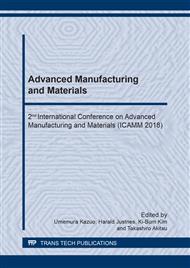[1]
Stewart, B. T., Carlson, L., Hatcher, K. W., Sengupta, A., & Burg, R. V. Estimate of Unmet Need for Cleft Lip and/or Palate Surgery in India. JAMA Facial Plastic Surgery,18(5), 354, (2016).
DOI: 10.1001/jamafacial.2016.0474
Google Scholar
[2]
Shajahan P. A., R. Raghavan, R. Bos, Geethprasad T. S. Prosthodontics Approach for the Fabrication of Feeding Plates in Cleft Palate Patients. Science Journal of Clinical Medicine. Special Issue: Clinical Conspectus on Cleft Deformities. 5(4-1):31-36, (2016).
Google Scholar
[3]
Mccomb, H. K., & Coghlan, B. A. Primary Repair of the Unilateral Cleft Lip Nose: Completion of a Longitudinal Study. The Cleft Palate-Craniofacial Journal,33(1), 23-31, (1996).
DOI: 10.1597/1545-1569(1996)033<0023:protuc>2.3.co;2
Google Scholar
[4]
Amlani, G. N. Art and science of cleft lip and cleft palate repair(Vol. 1). New Delhi, India: Jaypee Brothers Medical (P), (2017).
DOI: 10.5005/jp/books/13096_9
Google Scholar
[5]
Vrebos, J. Cleft Lip Surgery in Anglo-Saxon Britain: The Leech Book (circa A.D. 920). Plastic and Reconstructive Surgery,77(5), 850-853, (1986).
DOI: 10.1097/00006534-198605000-00031
Google Scholar
[6]
Mulliken, J. B. Correction of the Bilateral Cleft Lip Nasal Deformity: Evolution of a Surgical Concept. The Cleft Palate-Craniofacial Journal,29(6), 540-545, (1992).
DOI: 10.1597/1545-1569(1992)029<0540:cpclnd>2.3.co;2
Google Scholar
[7]
Mulliken, J. B. Principles and Techniques of Bilateral Complete Cleft Lip Repair. Plastic and Reconstructive Surgery,75(4), 487, (1985).
DOI: 10.1097/00006534-198504000-00004
Google Scholar
[8]
Randall, P. History of Cleft Lip Nasal Repair. The Cleft Palate-Craniofacial Journal,29(6), 527-530, (1992).
DOI: 10.1597/1545-1569(1992)029<0527:hoclnr>2.3.co;2
Google Scholar
[9]
Cronin, T. D., & Upton, J. Lengthening of the Short Columella Associated with Bilateral Cleft Lip. Annals of Plastic Surgery,1(1), 75-95, (1978).
DOI: 10.1097/00000637-197801000-00015
Google Scholar
[10]
Yildirim, S., & Aköz, T. A Simple And Cheap Nostril Retainer: Silicone Urine Catheter. Plastic and Reconstructive Surgery,107(5), 1308-1309, (2001).
DOI: 10.1097/00006534-200104150-00039
Google Scholar
[11]
T. Niimi, N. Natsume, T. Tsukawaki, H. Furukawa, H. Masuda, M. Kobayashi, T. Kawai, Treatment of the nostrils in patients with cleft lip by a nostril retainer, British Journal of Oral & Maxillofacial Surgery, 38:224-226, (2000).
DOI: 10.1054/bjom.1999.0174
Google Scholar
[12]
Vasudevarao Bharath, Dharma P. Natarajan, Mark Henderson, Sensitivity of Rp Surface finish To Process Parameter Variation, (2000).
Google Scholar
[13]
Kruth, J., Leu, M., & Nakagawa, T. Progress in Additive Manufacturing and Rapid Prototyping. CIRP Annals, 47(2), 525-540, (1998).
DOI: 10.1016/s0007-8506(07)63240-5
Google Scholar
[14]
Onuh, S.O., Yusuf, Y.Y., Rapid prototyping technology: applications and benefits for rapid product development, Journal of Intelligent Manufacturing 10(3-4):301-311, (1999).
Google Scholar


